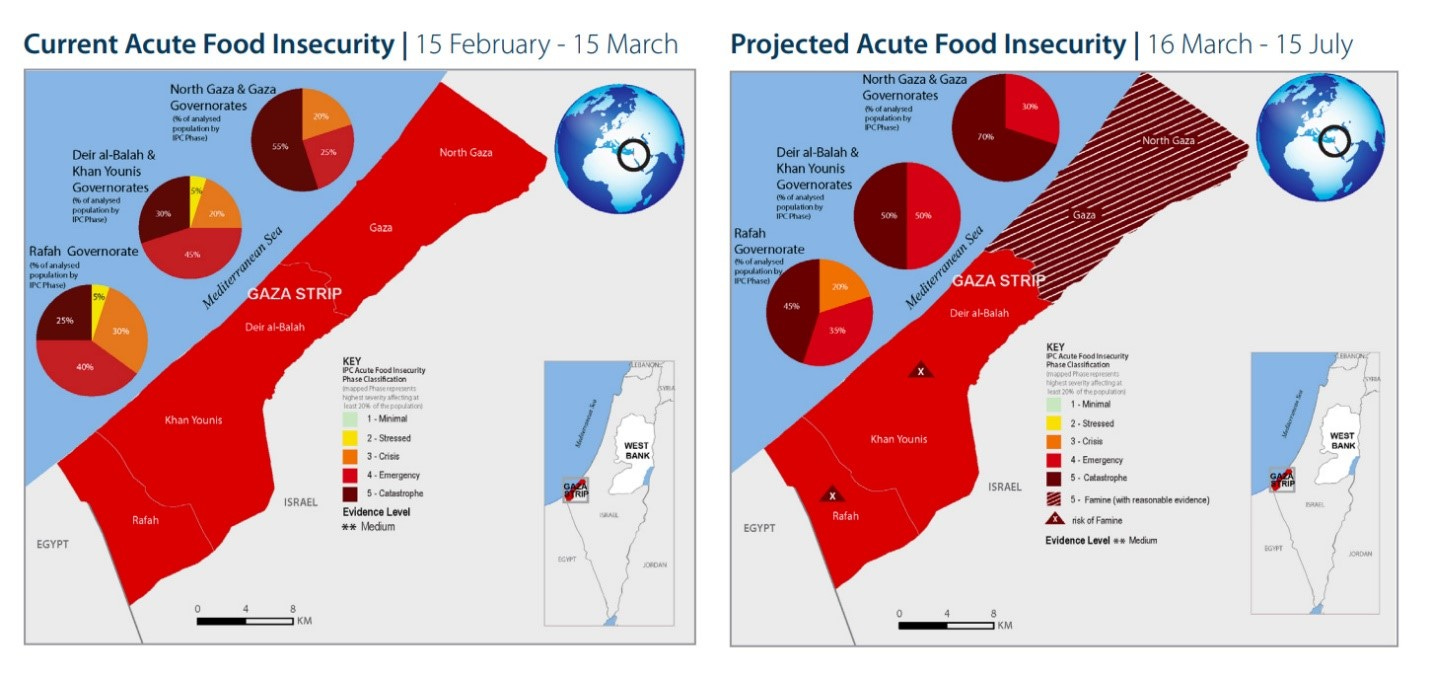[Just one post a week for the Easter break.
This is adapted for A level Geography students from the recent Substack by Frances Coppola found here .]
The above was the headline in the Wall Street Journal recently. The background to the headline was the release of a report from the International Food Security Phase Classification (IPC), a partnership of 15 international agencies and NGOs. It is now widely reported that more than a million people in the Gaza Strip, around half of the enclave’s population, are experiencing famine conditions, together with a sharp increase in child mortality.
The problem with the headline is that there is debate over the meaning of ‘starving’. For most, the definition of starvation is involuntary food deprivation. People who are starving do eat - they just don’t eat enough to survive – leading to malnutrition.
The World Food Summit of 1996 defined food security as existing ‘when all people at all times have access to sufficient, safe, nutritious food to maintain a healthy and active life.’ It can also be defined as including both physical and economic access to food that meets people’s dietary needs as well as their food preferences. The opposite of food security is food insecurity.
· The IPC distinguishes between chronic food insecurity, acute food insecurity and acute malnutrition. The report concerns itself with acute food insecurity in Gaza, though there is almost certainly acute malnutrition there as well, especially in the north of the area.
· The IPC defines chronic food insecurity as: persistent or seasonal inability to consume adequate diets for a healthy and active life, mainly due to structural causes.
· The IPC defines acute food insecurity as: food deprivation that threatens lives or livelihoods, regardless of the causes, context, or duration. In short, it kills. Is this the meaning of starvation?
The IPC identifies five phases of acute food insecurity (Table 1):
Phase 1: Food security
Phase 2: Stressed
Phase 3: Crisis
Phase 4: Emergency
Phase 5: Catastrophe
Table 1. IPC – General profile of the elements for each phase
Is it fair to state that Phases 3, 4 and 5 represent starvation?
The charts below (Figure 1) from the IPC report show the number of Gazans currently in each phase of acute food insecurity, together with the projection for the next four months. Using Figure 1, the headline at the head of this post may suggest that only Phase 5 represents starvation.
Figure 1. Gaza – Acute food insecurity numbers: recent past; near future.
Spatially, the whole of Gaza is currently in Phase 4, and the north is about to move into phase 5: (Figure 2).
Figure 2. Gaza – Acute food insecurity mapped: recent past; near future.
The IPC also warns that in the north of Gaza, famine is imminent. Famine is a rare occurrence for which the criteria include acute food insecurity and acute malnutrition, both generalised across an entire area, with high mortality.
As with acute food insecurity, the IPC identifies five phases in the development of malnutrition:
Phase 1: Acceptable (i.e. none or minimal)
Phase 2: Alert
Phase 3: Serious
Phase 4: Critical
Phase 5: Extremely critical
The IPC says conditions in Gaza make it difficult to screen for malnutrition, but measures of mid-upper arm circumference in children indicate that in February, north Gaza entered phase 4-5 (Critical to Extremely Critical) and Khan Younis phase 3-4 (Serious to Critical). Other areas are in phase 1-2 (Acceptable to Alert) as of early March.
The famine warning is not new. The IPC said in December that there was a risk of famine in the north of Gaza by the end of May 2024 unless there was an immediate ceasefire and sustained provision of essential supplies and services to the population there. It has also extended its warning to other areas of Gaza including the southern governorates of Deir al-Balah and Khan Younis, and the Governorate of Rafah.
An Israeli government spokesman, Eylon Levy, has disputed the IPC’s report, saying in a post on X that it was ‘based on an out-of-date assessment, and as such does not take account of the recent efforts to turbocharge aid deliveries to the minority of Gazans still in the north.’ By the nature of its timing of publication, the report does not consider the latest developments on the ground such as the air drops of recent weeks, or any recent aid convoys or the aid ship which recently sailed from Cyprus.
Israel also disputes with the UN about who is responsible for aid not reaching the north. Aid agencies say Israel is delaying the entry of aid and blocking the import of many essential items. Israel insists it is not imposing any limits or blocks; the problem is, they say, that the UN is not distributing the aid. Hundreds of trucks queue outside Gaza for days waiting for checks to be performed. Inside Gaza, especially in the north, distribution of aid is extremely hazardous: roads have been destroyed, there is unexploded ordnance and shrapnel, bombed-out buildings can collapse at any time, and there is the risk of attack by Israeli forces.
Gaza is a man-made famine area, which many would describe as being completely preventable.






